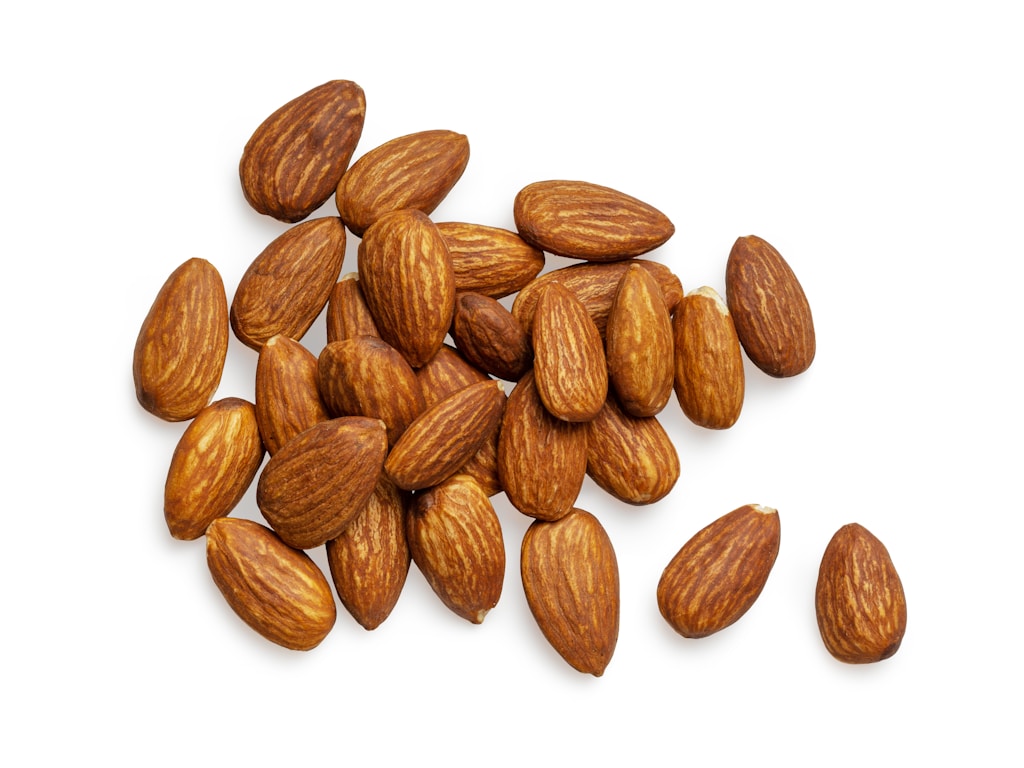夏威夷豆 / 杏 仁 / 腰 果 / 核 桃 / 胡 桃 / 南瓜子 / 巴西豆 / 開心果 / 榛 果 / 松 子 /
杏仁堅果以其獨特的風味、酥脆的口感和眾多的健康益處而廣受歡迎。這些樹果是杏仁樹(Prunus dulcis)的可食用種子,栽培已有數千年的歷史。杏仁在各種美食中廣泛使用,並因其營養價值而受到認可。在本文中,我們將探討杏仁的歷史、營養價值、健康益處、烹飪用途以及注意事項。
1. 引言
杏仁有著豐富的歷史,可以追溯到古代文明。它們被認為起源於地中海地區,並在古埃及、希臘和羅馬時期得到栽培。杏仁樹屬於薔薇科,與櫻桃、桃子和李子等其他核果樹密切相關。如今,加利福尼亞州是全球最大的杏仁生產地,其次是西班牙和伊朗等國家。

2. 歷史與栽培
杏仁擁有豐富的歷史,起源於古代文明。它們被認為起源於地中海地區,並在古埃及、希臘和羅馬時期得到栽培。杏仁樹屬於薔薇科,與櫻桃、桃子和李子等其他核果樹密切相關。如今,加利福尼亞州是全球最大的杏仁生產地,其次是西班牙和伊朗等國家。
3. 營養價值
杏仁富含豐富的營養素,對整體健康有益。讓我們來探討一下它們提供的各種營養價值:
3.1 富含健康脂肪
杏仁是健康脂肪的良好來源,主要是單不飽和脂肪。適量攝入這些脂肪有助於降低壞膽固醇水平,減少心臟疾病的風險。
3.2 高抗氧化物含量
抗氧化劑在保護細胞免受有害分子(稱為自由基)損傷方面起著關鍵作用。杏仁富含抗氧化劑,包括維生素E,有助於中和自由基並支持皮膚健康。
3.3 維他命來源
杏仁含有多種重要的維生素,包括維生素E、維生素B2(核黃素)和維生素B3(菸鹼酸)。維生素E具有抗氧化作用,而核黃素和菸鹼酸參與能量產生並支持腦功能。
3.4 礦物質提供
杏仁是鎂、錳和磷等礦物質的良好來源。鎂對肌肉功能至關重要,而錳和磷則有助於骨骼健康和能量代謝。

4. 健康益處
定期食用杏仁有許多健康益處。讓我們探索一下與這些營養豐富的堅果相關的好處:
4.1 促進心臟健康
杏仁中的健康脂肪、抗氧化劑和纖維有助於降低心臟病的風險。這些營養素有助於降低壞膽固醇水平、維護血壓穩定並減少炎症。
4.2 支持腦功能
杏仁中的維生素E和其他抗氧化劑可能有助於支持腦健康和認知功能。這些營養素有助於保護大腦免受氧化壓力和年齡相關衰退的影響。
4.3 幫助體重管理
儘管杏仁熱量較高,但對於體重管理具有益處。杏仁中的纖維、蛋白質和健康脂肪有助於產生飽腹感,減少過食的可能性。將杏仁作為零食或均衡餐的一部分,可以支持減重或保持體重。
4.4 改善消化系統
杏仁富含膳食纖維,有助於消化並促進腸道規律。飲食中納入杏仁可以幫助預防便秘,維持健康的消化系統。
5. 烹飪用途和食譜
杏仁在廚房中非常多用途。以下是一些常見的烹飪用途和使用杏仁的食譜:
5.1 零食和烘焙
杏仁本身作為零食非常美味,也可以與乾果或黑巧克力結合食用。它們還可以用於烘焙各種點心,如餅乾、蛋糕和燕麥棒,增添美妙的口感和堅果風味。
5.2 杏仁奶和奶油
杏仁奶已成為傳統牛奶的無乳製品替代品。它是通過將浸泡過的杏仁與水混合後過濾而成。杏仁奶通常用於製作咖啡、茶、營養奶昔和各種飲品。此外,杏仁奶可以用於製作非乳製品的奶油,適用於烹飪和烘焙。
5.3 杏仁粉和油
杏仁粉是將杏仁研磨成粉狀的產品,常用於烘焙和糕點製作。它可以用作麵粉的替代品,使食物更豐富和堅果香。杏仁油則常用於烹飪、沙拉調味和美容產品。

6. 過敏和注意事項
儘管杏仁是一種營養豐富的堅果,但有些人可能對它們過敏。如果您對堅果過敏或有其他過敏症狀,應避免食用杏仁或在使用產品時謹慎。
此外,杏仁中含有草酸,可能對某些人造成不適。如果您有肾結石或其他相關問題,建議在食用杏仁前諮詢醫生建議。
7. 杏仁產業與市場
全球杏仁產業不斷增長,需求持續上升。加利福尼亞州是最大的杏仁生產地,該地區的氣候和土壤條件非常適合杏仁樹的生長。此外,其他國家如西班牙和伊朗也是重要的杏仁生產國。
8. 結論
杏仁是一種美味、營養豐富的堅果,具有多種健康益處。它們富含健康脂肪、抗氧化劑、維生素和礦物質,有助於促進心臟健康、支持腦功能、幫助體重管理和改善消化系統。您可以在烹飪中廣泛使用杏仁,包括製作零食、烘焙、製作杏仁奶、使用杏仁粉和油等。然而,如果您對堅果過敏或有其他健康問題,應謹慎食用或諮詢專業意見。

儘管杏仁被歸類為堅果,但它們屬於不同的植物科,因此一些對堅果過敏的人可能能夠耐受杏仁。然而,如果您有堅果過敏,食用杏仁前應咨詢醫療專業人士的建議。
是的,將杏仁納入均衡飲食中有助於減肥。杏仁中的纖維、蛋白質和健康脂肪能夠增加飽腹感,控制食慾並避免過食。
是的,可以在各種烹飪和烘焙食譜中使用杏仁奶替代乳製品。然而,需要注意的是,杏仁奶的質地和味道可能與乳製品略有不同,因此在某些食譜中可能需要進行調整。
為了保持杏仁的新鮮度,最好將其存放在密封容器中,放在陰涼乾燥的地方。另外,您也可以將杏仁放在冰箱或冷凍庫中以延長其保存時間。
是的,杏仁油具有保濕功效,可用於護膚。它有助於滋養和保濕皮膚,因此在乳液、霜類產品和按摩油中常常使用杏仁油作為成分。
Contact Info:

Introduction of Almond Nut
Almonds are highly popular nuts known for their distinct flavor, crunchy texture, and numerous health benefits. These tree nuts are the edible seeds of the almond tree (Prunus dulcis) and have been cultivated for thousands of years. Almonds are widely used in various cuisines and have gained recognition for their nutritional value. In this article, we will explore the history, nutritional benefits, health advantages, culinary uses, and precautions associated with almonds.
1. History and Cultivation
Almonds have a rich history dating back to ancient civilizations. They are believed to have originated in the Mediterranean region and were cultivated in ancient Egypt, Greece, and Rome. The almond tree is a member of the Rosaceae family and is closely related to other stone fruits such as cherries, peaches, and plums. Today, California is the largest producer of almonds globally, followed by countries like Spain and Iran.
2. Nutritional Benefits
Almonds are packed with essential nutrients that contribute to overall well-being. Let’s explore the various nutritional benefits they offer:
3.1 Rich in Healthy Fats
Almonds are a great source of healthy fats, primarily monounsaturated fats, which are beneficial for heart health. These fats help reduce bad cholesterol levels and lower the risk of heart disease when consumed in moderation.
3.2 High in Antioxidants
Antioxidants play a crucial role in protecting our cells from damage caused by harmful molecules called free radicals. Almonds are rich in antioxidants, including vitamin E, which helps neutralize free radicals and supports skin health.
3.3 Good Source of Vitamins
Almonds contain several essential vitamins, including vitamin E, vitamin B2 (riboflavin), and vitamin B3 (niacin). Vitamin E acts as an antioxidant, while riboflavin and niacin are involved in energy production and support brain function.
3.4 Provides Minerals
Almonds are a good source of minerals like magnesium, manganese, and phosphorus. Magnesium is crucial for muscle function, while manganese and phosphorus contribute to bone health and energy metabolism.
4. Health Benefits
Consuming almonds regularly offers various health benefits. Let’s explore some of the advantages associated with these nutritious nuts:
4.1 Promotes Heart Health
The healthy fats, antioxidants, and other nutrients found in almonds contribute to heart health. Studies have shown that incorporating almonds into a balanced diet can help reduce the risk of heart disease by improving cholesterol levels and reducing inflammation.
4.2 Supports Brain Function
The combination of vitamin E and other antioxidants in almonds may support brain health and cognitive function. These nutrients help protect the brain from oxidative stress and age-related decline.
4.3 Aids in Weight Management
Despite being calorie-dense, almonds can be beneficial for weight management. The fiber, protein, and healthy fats in almonds promote feelings of fullness, reducing the likelihood of overeating. Incorporating almonds as a snack or part of a balanced meal can support weight loss or maintenance.
4.4 Improves Digestive Health
Almonds are rich in dietary fiber, which aids in digestion and promotes bowel regularity. Including almonds in your diet can help prevent constipation and maintain a healthy digestive system.
5. Culinary Uses and Recipes
Almonds are incredibly versatile in the kitchen. Here are some common culinary uses and recipes involving almonds:
5.1 Snacking and Baking
Almonds are delicious when enjoyed as a snack on their own or combined with dried fruits or dark chocolate. They can also be used in baking various treats like cookies, cakes, and granola bars, adding a delightful crunch and nutty flavor.
5.2 Almond Milk and Butter
Almond milk has gained popularity as a dairy-free alternative to traditional milk. It is made by blending soaked almonds with water and then straining the mixture. Almond milk is commonly used in smoothies, cereal, and coffee. Almond butter, on the other hand, is a creamy spread made from ground almonds and can be used as a substitute for peanut butter.
5.3 Almond Flour and Oil
Almond flour, made from finely ground almonds, is a gluten-free alternative to wheat flour. It is commonly used in baking and cooking, particularly for those following a gluten-free diet. Almond oil, extracted from almonds, has a mild nutty flavor and is often used in salad dressings or as a finishing oil for dishes.
6. Allergies and Precautions
While almonds offer numerous benefits, it’s essential to be aware of potential allergies and take necessary precautions. Some individuals may have almond allergies, which can cause severe reactions. If you experience any allergic symptoms after consuming almonds, it’s advisable to consult a healthcare professional.
7. Almond Industry and Market
The almond industry has experienced significant growth over the years, driven by increased consumer demand for healthy snacks and plant-based alternatives. The global almond market continues to expand, with almonds being used in various food products, including snacks, confectionery, and bakery items.
8. Conclusion
Almonds are not only delicious but also packed with essential nutrients that promote overall health. From their rich history to their culinary versatility and numerous health benefits, almonds have become a staple in many diets worldwide. Whether enjoyed as a snack, used in baking, or incorporated into various dishes, almonds offer a satisfying crunch and contribute to a well-rounded, nutritious diet.











Leave a Reply